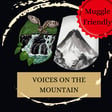Become a Creator today!Start creating today - Share your story with the world!
Start for free
00:00:00
00:00:01

Digestion Points Part I
What's my name?!?! Insight into points comes through many avenues, but the perhaps the most fundamental is the name. The ancients wrapped enormous understanding, experience and clinical guidance into the names of every point, and all we have to do is decipher them in the context in which they were given. Based on Nei Jing concepts and excerpts, we delve into key digestive points. We discuss the Great Luo ot the Stomach called 虚里 xū lǐ, and how that provides great insight into points like ST36 足三里 zú sān lǐ, ST37 上巨虚 shàng jù xū, etc.
And check out the second half of this content in the subsequent episode.
Transcript
Introduction and Significance of Point Names
00:00:08
Speaker
This week with voices on the mountain, we have Dr. Steven Wong and Asher Lauren. We're going to talk about what we're going to talk about. We're going to talk about points and their names. Yeah, let's get some of those points. Yeah. So we learned the numbers here in America. They don't tell you a lot about the point. They tell you in what order they fall in numerically, but that's about it.
Translating Point Names: Challenges and Anatomical References
00:00:32
Speaker
When talking to Steven, you usually have to use the pinion at the very least, a translation of the English name to get him to know where the point is, or you can just tell him where the point is. I'll take anatomical or even just a finger pointing, right? This one. This one over here. Yeah, that one.
00:00:52
Speaker
But the names tell us a lot about what's in, what the point is for and what it's doing there. And it gives you a little bit more context. And sometimes the point translations that we get out of dead men aren't super accurate.
Misconceptions and the Energizing Myth
00:01:07
Speaker
So the first time I remembered Stephen dropping a point name knowledge was in clinic form. And the previous one we had just talked about everyone's favorite point.
00:01:17
Speaker
Doosan Lean, stomach 36, and the professor before was like, oh yeah, you know, if you need to walk an extra three miles, you massage this point and boom, you're like, you're ready to go. You know, it's there to energize you. And Steven came in on the next form and he was like, that is the most ridiculous thing I've ever heard. What are you guys talking about? I'm not opinionated, dude.
00:01:43
Speaker
I'm just kidding. No, no, no, I'm a bitch sometimes. I take it. I take it. I don't think bitch is right. I prefer because I've been called judgmental. I prefer highly delineating. Oh, okay. Yeah, highly delineating. Yeah. And strong feelings about
00:02:03
Speaker
Yeah. Authenticity. It's like I delineate between what is useful and what is bullshit.
The Necessity of Learning Chinese for Understanding
00:02:10
Speaker
I dig it. I'll take that. It sure sounds nicer.
00:02:16
Speaker
So Zusan Li, what's it mean, Steven? Okay, so Zusan Li, I'm going to lay down a couple of things. First of all, I really appreciate people trying to learn their point names. So even when things get, you know, hilariously off track or not hilariously, you know, just but just like it's adorable, you know, I shouldn't add.
00:02:34
Speaker
I don't want to go into it. But what I mean is, if you miss the mark, you miss the mark, but at least try. And I always tell people, at least in America, you don't have to be a master of Chinese. I would recommend you learn some because people here often have this nagging feeling in the back of their head a lot of times that they're missing stuff. And part of the time is because we're really missing stuff. I mean, look at Machocha's books.
00:03:00
Speaker
He misses stuff. But the problem here is, what is he missing? It doesn't mean everything in Machocha's books is wrong. It just means he's missing stuff. And he's getting something wrong, some things aren't even in the book, all that sort of thing. But how are you going to know? Well, learn a little Chinese. And again, I don't expect anybody to be reading textbooks in Chinese anytime soon. But the more you know, the less you have to worry that you're missing stuff or that you're
00:03:23
Speaker
Overlooking stuff. So I think it's an empowering thing for
Translation Errors: The Case of Zusan Li
00:03:26
Speaker
people. I know it's it's a big Daunting task to try and pick up Chinese, but just start, you know, just start somewhere So anyway going back to zusani people directly translate that and that they get into a little bit of trouble But at least to try and you know give them props out a shout out to that but the big one is they'll probably use some sort of like I don't know dictionary and just input them one at a time and they get foot three mile and that's a
00:03:51
Speaker
Big problem. Foot, I think we all understand. It's not actually your feet. It's your feet channels, which is actually your lower body channels. So it's not just that your feet work better. It's literally your lower body channels, but that's not too hard to figure out. Three, it is. There are some ways that we read into numbers differently, but this really is three. And then that last word, mile, people are like, really? So if I push this or I needle this, I can walk three more miles. What if I go up to my hand point, was that large intestine 10?
00:04:21
Speaker
that's hand shows on me. So does that mean I get to handstand three more miles? What does that mean?
The Stomach's Great Law in Chinese Medicine
00:04:28
Speaker
If this li means miles, tell me what's going on, right? And they're like, oh no, that one's also good for miles. Really? On my large intestine channel? Nobody uses that for that, anyway. So the point here is that they're missing that li is actually a reference to the stomach's great law.
00:04:46
Speaker
So big shout out to the Ne Jing here. There's actually 16 lore, but there's only 15 lore points. So we got all 12 lore, and we've got the Ren and the Du. But then we also have the spleen great lore, which makes 15. And of course, we have that spleen point, Dao Bao. I think that's 21, right?
00:05:09
Speaker
And then we also have the stomach's great law, but it doesn't have a point. So there's a law, but there's no law point for that one. That's the 16th law.
00:05:19
Speaker
So this one actually in the in this is in the nejing this is all coming straight out of the nejing and in fact not only does this law exist but it has its own name and it's called shu li and hence that li is a reference to the stomach right or in this case the entire abdomen what we refer to the three different abdominal compartments
00:05:40
Speaker
So Shosanbi is treating the upper third of the abdomen and stomach tract, the middle third and the bottom third, hence all three parts of that gastrointestinal tract. Wow. I didn't even know about the stomach great low. It's so interesting. It seems very vital and yet missed. Is the shoe just a hole? Is that the same back shoe kind of shoe? X-U. Yeah, X-U.
00:06:09
Speaker
So today we're also going to go over some key points. Those stomach points. They come after. So I guess 37 and 39. The other seas of blood. The seas of blood. New Netflix special. No one saw that coming. Exactly. So that's that shoe. But it doesn't mean deficient. It is the same word as deficient. So shoe and sure. X you
00:06:39
Speaker
But in this case, that's why those point names wouldn't make sense. Why would we hit a point that's called deficiency? Because it's not referring to deficiency, it's referring to the stomach great law. And it also brings us to an interesting point too. Why in the world are there great law? Da law. Why do they have these? Well, it's no coincidence that one's the spleen and one's the stomach because everything comes from your spleen and stomach. That's all your houtian, that's all the postnatal, everything comes from spleen and stomach.
00:07:07
Speaker
Yeah, very useful to have the lateral collaterals that are going out and nourishing everything. Totally. Seems beneficial for the body to not just go up longitudinally. Yeah. The Nijing even tells us where the great law of where it goes. The stomach law is actually pretty small. It's right there just kind of peripherally around the epigastric area and then goes in
00:07:34
Speaker
We can actually we'll do that later. Well, we'll do that one Worked forward for y'all because I think we should do probably do a channels Episode or we can do at least some of the channels but like just explain to people like where should you get your channels from done aging? You know and sometimes dead men what we'll add some things. Yeah Yeah, I haven't read them all but I started the long channel. I was like enough of this There's nothing that refers to a throat
00:08:03
Speaker
So you first dropped some of this knowledge on me years ago, and then I've had some time to think about it. And I've also reviewed some more points. And then, you know, the other day I ran into some more Li points. Zhu Wu Li. Yeah. Very nice. On the liver channel. I don't know what number that's going to be. I want to guess 10, but it could be wrong. It could be 11.
00:08:28
Speaker
That sounds right. I'm literally the worst person that has that question too. And then the other one would be Shaowuli, which is also going to be on the large intestine channel. So my question for you is going to be, are these Lee the same Lee? They're translated as Miles. They have the same character. What's going on here?
00:08:50
Speaker
Solid. So when it comes to these Lee, by the way, every point, you know, there's some crossover, there's multiple words describing things. So it's true, you know, you got to learn everything in context, you got to see what channel it's on, you got to see what it does, all those things to really get the kind of breadth of whatever is going on.
Hand vs. Foot Points: Treating Conditions
00:09:07
Speaker
So the key here is it's still the hand and foot. And we haven't really gone over that yet. But
00:09:12
Speaker
In general, hand points tend to treat the exterior much better, or external pathogens better. And foot points tend to treat internal function, or in this case, often dysfunction much better. And that's just because the upper part of our body is more exterior, and the deeper part of our body is more interior. Shout out to the triple burner for all you guys. If you guys noticed that the upper burner isn't just vertically higher, it's actually more superficial.
00:09:39
Speaker
middle burner going inward and then the lower burner isn't just lower vertically in your body it's actually the deeper center of your body.
00:09:47
Speaker
Nice. I think I missed that, but that's a nice correlation and pattern there. So you can see that correlates to the hand and the foot idea here. We've got here the hand and foot, so we still get that correlation. We'll talk a little bit more about that when we talk about shou-san-ni versus shou-san-ni.
00:10:09
Speaker
Then here, the Wu can actually refer to two different things. So it is a different number. It's five. But that actually refers to a couple different things. And there is some controversy on this one. So first thing that some people say is that five is a spleen number because one, two is wood number, three, four, fire number, five, six, spleen number.
00:10:31
Speaker
Yeah, I think I've heard that too, where it's like you have the four directions and then they circle around the fifth. Right. The same thing where you put the five elements in a wheel and put the spleen in the center of the spoke. So that'd be the fifth point that then is turning the other four. Totally. Kind of the quote unquote fifth season, the fifth direction, which is the center. Yeah.
00:10:53
Speaker
Yeah, so the five, wu could refer to all of those. It's reasonable, because obviously we don't have five compartments in our three compartment digestive area. Right, okay, yeah. So that's one understanding of wu. But here's an interesting point. So when we talk about the three different wan, or the three different li, as we were mentioning before, it's actually those are two words are interchangeable. When we really talk about those three compartments, what we're really doing is we're subdividing the middle
00:11:22
Speaker
and the lower burner into three parts. So we're leaving off the upper burner. We just got middle and lower because we're starting at stomach. We know that makes sense, GI. So once we start in the middle, we actually take the top two thirds of that middle burner and we call that a separate name.
00:11:38
Speaker
That's the first or upper wan. That's also called the upper li. And hence, you know, that's why wan and li are interchangeable. Well, then what's the second one? It's the bottom third of that middle burner and the top third of the lower burner. So right around peri-naval area, that's the middle zhongwan or middle li. Middle wan or middle li. And then the lower wan, that's the bottom two thirds of the triple, the third lower burner.
00:12:06
Speaker
Huh. Because the description of the upper two-thirds made me think of how the spleen channel kind of comes in and almost is like the pancreas in the stomach and the small intestine, the top part of the small intestine.
00:12:24
Speaker
Yeah. All kind of like duodenum nicely with that primary spleen channel. Heck yeah. And it's very digestive folk. Like that's where most of your digestion is happening. Totally. That's where certainly all the exocrine stuff is, like the duodenum where the bile and the enzymes and everything are coming in. Yep. All the best sphincters. And then the lower, it's a fun word to say. Yeah, sphincter of Adi's there. Who doesn't want to name a sphincter?
00:12:50
Speaker
No way. It's named after a person. I think Adi is. Yeah, I think that's a dude's name. That's terrible. I would hate to have anything. No Asher sphincter. No, please God, no. A Wong sphincter would be funny though. This is a Wong sphincter. Yeah. Cause I feel like Germans would, those are my bad German accent, but I feel like they were the ones who were figuring it out. This is a Wong sphincter. So the lower two thirds.
00:13:21
Speaker
No, they'll say the last part again, the lower bit of the, of the lower one, the lower one, that's the lower two thirds of the lower burner. So if you want to roughly describe this, it's just like Asher was saying, it's stomach and duodenum at top. So that definitely includes where the bile is coming in and all that stuff. It's peri-naval in the middle, right around your belly button. And then it's large and test me on the way out. And that's the lower part.
00:13:48
Speaker
Do we throw the bladder in on the lower one too? We could, but the interesting thing is when we subdivide like this, we're actually mostly just talking about the digestive tract. Got it. Awesome. How does this tie back to the five? Oh, yes. By the way, tie, as in tie in, how do we tie this one in?
00:14:12
Speaker
Yeah. Give me the greater knowledge base here. Oh, snap dude. Azure is bilingualing me. This is a good pun, this man. So yeah, the five can correlate to that middle burner, right? Five, six are also the two stomach spleen numbers. It can refer to the middle being the fifth direction, the fifth, all that. And then I would point to another option.
00:14:40
Speaker
That other option is, well, okay, we've got all three li covered. We know that that's there. That makes tons of sense. We use tsu-san-li for upper, middle, and lower digestive tract problems. That one all makes sense. But where in the world could we get four and five? And what would that be? And if you think about it, when we're talking about this specifically, not again as burners, because remember, burners are large.
00:15:02
Speaker
There's no way to say the heart is more of an upper burner or the lung is more of an upper burner. It's just the upper burner. It's the entire cavity of that upper cavity of the torso. Well, when it comes to the wan and the li, we're really talking about the tract, but there are helpers. It's not just the stomach tube, stomach and large intestine tube. If you think about what are the two best helpers, liver, gallbladder. And if you add that up together, arguably you get the five.
00:15:29
Speaker
different components. Well, then how would we make sense of this? Because this is a really good way of people being like, OK, well, there are different ideas. How can we make sense of this contextually? Go to the indications and go to see what those points are for. So if you go to Zhuuli, according to Zhengzhou Dacheng, one of the best books on tons of acupuncture stuff, Ming Dynasty, it says it's good for abdominal fullness, or they call it Fu Zhongman.
00:15:59
Speaker
And we'd say, okay, what does that mean? Actually, a lot of times what we're talking about there is ascites. So this is liver really blocked up, right? It could be cirrhosis, it could be other things, jaundice, where that fluid is dropping into the abdomen. Well, again, it's the liver gallbladder problem. Even the liver and gallbladder are not technically part of that tract, right? The GI tract, if we could call it, specifically just starting at the stomach and ending at the anus.
00:16:27
Speaker
And then you could say, okay, well, what else is zuwuli for? So, fujong man was one of them. It's also good for ruobi bute, so which means now, which means urine. So it means they've got hot blockages that where they can't urinate. That is like one of the best descriptions for most jaundices. It's a hot blockage.
00:16:49
Speaker
in the liver gallbladder that doesn't allow the person to urinate and therefore they get this buildup of what we call danjir gallbladder juice, second only to beetle juice. And so then they lose their urination function and they can't clear it out. So for any of you guys out there treating jaundice patients, we have incredible herbs for this. But don't forget yinchan hotong for damp heat jaundice, which is the most common one, has to have jerza because it opens up the urination.
00:17:17
Speaker
So that was a long way roundabout way for me to say. Heat blockages that can't urinate sure does look a lot like jaundice. And so you start seeing, oh, this liver point called zululi on the liver channel, of course, looks like it's great. But what about shouli? It's not on the liver channel. Let's see what that does. So also from Jinjo Dachong,
00:17:40
Speaker
It says it treats a number of things. First thing it says it treats is coughing blood and vomiting blood. And for those of you out there who treat a lot of
00:17:50
Speaker
lung issues and so forth, you'll know that one of the most common ways that we get lung bleeding and coughing up blood is actually liver fire transmitting directly to the lungs. So this is an internal fire, not an external fire. Still, we're pulling some livery stuff and they're like, okay, well, how full? And then, or how connected? Let's see if there's anything else. It also says, xin xia, zhong man, fullness and distention underneath the heart. Getting pretty close.
00:18:18
Speaker
The body is yellow. That's literally jaundice. We just literally said jaundice. It also says, which means periodically there's slight fever, which means could translate to intermittent fever and chills. Shout out to the shyong layer and which is blockages along the liver gallbladder travel over the
Large Intestine Points and Liver Conditions
00:18:39
Speaker
neck.
00:18:39
Speaker
It's a large intestine point. Why is it so liver gallbladder focused? It's up to you, but I would say because the Wu, the five is referring to, is including the liver gallbladder in there. And shout out to liver gallbladder. Liver zang transports for spleen zang. Gallbladder fu transports for stomach fu. Nice.
00:19:01
Speaker
I think that was a very good synthesis and thesis put forward by you. Definitely got me turned on to that. Yeah, the other things that make me think about the large intestine, we use it to treat liver in other ways too. I mean, the four gates would be like the most common one where people are using, because they always say, oh, they have liver cheese stagnation, use the four gates.
00:19:27
Speaker
Not my personal favorite, but if you're doing that, part of your idea, I think should probably include that the large intestine is treating the liver in some way. You have metal controlling wood and you also have the branch pair connection that we use in the dong styles or the balance method.
00:19:47
Speaker
where Arm Yang Ming is going to treat leg joy in. I dig it. I dig all three of those, man. Yeah, the Four Gates is a fascinating one. Maybe we'll add that on this a little bit today too.
Debating the Effectiveness of the Four Gates
00:20:00
Speaker
Yeah, a whole episode just on the Four Gates. Should it be used as often as it's being used, or is it just a powerful combination that can get results, but maybe not the results that you actually want? Exactly.
00:20:15
Speaker
And there's some fun Chinese medicine, even like Beijing anatomy that goes in
00:20:21
Speaker
Ooh, well, okay, let's just do it now then. So the first thing that I thought of when we learned the four gates, and this is how I would go through school, is that you're given indications by teachers, you're given a protocol that's very powerful. And so my thing was, okay, try to explain what they're doing, how it's working. What's the real juice behind the magic? Just use magic because it's magical, let's figure it out.
00:20:48
Speaker
So one of my first ones was the branch pair connection, but then also the anatomical, where if you put your thumb over your big toe, you could stab through Heigu and hit Taichung. Yes. Where they are pretty much mirror points, yeah, on there. And then the last one that I found, which was way later, I was looking at divergent channels because I don't understand anything about divergent channels except that they're there and that they're doing stuff. That they diverge.
00:21:17
Speaker
Yeah. Maybe they're deeper, maybe they're not. I don't know what they're doing, man. We'll get there. But the most divergent channels break off knees and elbows or above, right? That's like the main pattern. But the liver and the large intestine are the exceptions, and they pull off right around liver three and large intestine four or tai chong and tegu.
00:21:42
Speaker
I don't know the exact text where they describe where it comes off. That might give us more hints as to where exactly anatomically. But based off of the descriptions and drawings I've seen, it's in that general vicinity. I love that addition, dude. We'll play it. Yeah, totally. I love that last one about the divergence band. We'll definitely do some more on that divergenty stuff and also just all the different layers. So totally solid knowledge on that one, Ashur.
00:22:11
Speaker
There's another thing too, which is if you go back to even the Beijing and stuff, you know, Qibou is telling us where's this, the anatomy and everything else like that. And they talk about what's called Qigu, which is actually the same Qigu for any of you kind of keeping track at home. That's the guy who, that's one of the two people in the Beijing, one of the two names, the other one being the Alember, of course.
00:22:34
Speaker
And then his word qi is actually the word for divergent or to split. And the bone spacing, this kind of big V shape between our thumb and our forefinger, as well as our large toe and our second toe, or big toe and our second toe, is called qi gu because it's got the bigger spacing than does any other of those five digits.
00:22:56
Speaker
And so what does qi mean? It means to diverge. It means to open up. It means a space, like a valley much larger than any others. And so we know from Chinese medicine that when you have these larger valleys, the whole point is how do you connect it?
00:23:12
Speaker
Well, there happens to be a point in the middle of both of those. In fact, the one up at the top, we all know it's called chögu, number four, large intestine four. That means combine the valley, literally reconnect the valley. And so what this is telling us is that we have a way of connecting the thumb to all other four fingers, meaning we can connect all the hand channels together.
Unifying Channels: Hand and Foot Points
00:23:36
Speaker
And anatomically, if we do the same thing on the bottom, we'll connect all the foot channels together. So it's not that the four gates necessarily open all liver G, but they do connect the hand channels together and the foot channels together simultaneously. That's a lot of gates. That's a lot of gates to open. Yeah. Uh, how flexible are your, are your toes? Cause I cannot touch my big toe to anything besides the one right next to it. Oh, you mean like, yeah.
00:24:03
Speaker
Uh, you know, everyone, my partners got a little bit more flexible toes than me, but other than that, uh, I think maybe some of the crazy ones could get to the third toe. Yeah. I'll, I'll work on it. Yeah. That's the homework for all you listeners out there. Yeah.
Different Uses of Zusan Li for Conditions
00:24:20
Speaker
Did you have a, cause we kind of glazed right over the Shao San Li, the large intestine 10. Oh, nice. Uh, Shao San Li. Yeah. Yeah. They definitely talk about MiC or matching that when you do stomach 36, Zu San Li, they're like, Oh, they have the same name, use them at the same time. Is it just rebuffering, uh, redoing of Zu San Li, or is it have its own kind of function separate? So silent, dude.
00:24:46
Speaker
So when it comes to Shōsan-ni, the big difference is that it's a shō, it's a hand point instead of or upper body point versus zō. And this is exactly the sort of, I'd recommend people get into this idea. Well, we said the upper ones are for external pathogens and so forth. So what is it really the best at?
00:25:07
Speaker
food poisoning, and other stuff. But it's where these external pathogens are coming in, causing vomiting, causing diarrhea, stomach pain, all the classic stuff. But there's an external pathogen to it. And what's the foot zusandhi for? Internal spleen and stomach deficiency, right? And so when we're talking about how do we strengthen that organ function, zusandhi, but how do we clear an external function or an external pathogen, zusandhi?
00:25:35
Speaker
So a good example is actually one of my herb students, she's great. She's really dedicated. She's in Costa Rica. I'll give her a shout out when you guys, if any of you guys are heading to Costa Rica, you should look her up. She's great. Anyway, she's got one of her two kids. He had like a big bad tummy ache and probably ate something funny, but she knew it was like, she got identified. Yeah, it was probably some food poisoning.
00:25:59
Speaker
And since they're kids, all you pretty much need is your hands. So she just rubbed, shows underneath for a couple of minutes, and he vomited. Then he started running around just like he was, like a normal kid again, because it just gets it out, right? It clears external pathogens really well. Oh, yeah.
00:26:15
Speaker
Yeah, that doesn't really work that well on adults, but you know, for kitties, they're so sensitive that usually if they're under three or five or so, you can get some really good results. Even up to like 10, we can use kid toina, but pediatric toina is insanely useful for the little ones. But up once they get to like five or seven, it starts waning in efficacy.
00:26:36
Speaker
Gotcha. In the dong method, they will talk about the hands being in the lower extremities, on the arms being, I guess it's the upper, more distal extremities, being yang within yang. And then as you get into the upper forearm and shoulder, it's yin within yang. That's right. And then the legs foot being yang within yin, and the thighs being yin within yin.
00:27:05
Speaker
Really? They don't say the feet is yin within yin. They're saying the thighs are yin within yin. Yeah, because the thighs being yin within yin, I think because they're like huge musculature, you know, big arteries are going through there. That's interesting. Yeah.
00:27:23
Speaker
That's interesting. The upper ones, heck yeah, heck yeah. The bottom ones, that's interesting to think about because a lot of Nijin quotes will talk about how like, so for instance, dampness is a yin pathogen, so it attacks our feet first because it's the most yin area. And wind being a yang pathogen, even though it has a yin effect in the body, but it is a yang pathogen. And so it affects the upper part of our body, i.e. the back of our neck first.
00:27:47
Speaker
Sure. So I'm thinking about this with patience because it's like on the one hand, yeah, for sure, like the cankles and the edema, like we'll go there first. But then on the other hand, there's a lot of people that will store a bunch of, I don't know, extra fat or in the thighs. True. And so you're saying? Yeah, or like one of the first things to like eat up that dampness and get big on a person's body who's getting bigger.
00:28:12
Speaker
Yeah. And where we're storing fat, I love what Asher's thinking about it. It's kind of where we're storing yin, but the whole musculature is also, that's also another one because we think the bigger, stronger muscles would be the yang within yin, right? I don't know. It's fascinating. We have to watch you battle it out with a, I should find a Master Dong practitioner for you to battle out with. Let's do it. Let's bring battle out. I mean, of course, in the most collegiate way, but it'd be great to get that on you. Yeah, totally.
00:28:37
Speaker
Interestingly, from a Bagua perspective, or any sort of internal martial arts perspective, all of our movement in Bagua definitively comes from our calves.
Bagua Martial Arts: Calves Power Movement
00:28:46
Speaker
So I always thought it was feet, you know, just usually people say like punch with your foot, which makes sense, be rooted, right? But it's actually the muscular explosion that happens in the calf that really fuels all of Bagua.
00:29:02
Speaker
I didn't learn this until my Ba Gua master in Beijing, I got to study with for four years, Master Gao Chi Wu, and he's 80, he's just so healthy and so strong for his age too. Man, he could just toss us around, no problem, no problem, and he's 80. But it doesn't matter how big you come, he'll show you all the good stuff. And just super wonderful gentlemen too, like literally the,
00:29:29
Speaker
the definition of what we're all aiming for, not just marshally, but also humanistically. Anyway, it was so funny because one time I was there studying with him, he's so darn diligent. He's there really early every morning. And he was like, Steven, feel my calf. And I was like, okay, all right. I'm feeling old people's calves in the park. I got this. But you feel his calf and you feel the muscular explosion anytime he wants to move, it's all fueled right from that calf.
00:29:56
Speaker
And so, yes, it's the lower limb below the knee that's fueling, but I just guess I always assumed it was our foot. According to Master Gao, it's actually our calf. So that's why one might say that that's the root of all movement. So however you want to say the yin within yin or yang within yin, depending on how you see that. And then the larger quad, which gets a lot of the credit, is actually the second one. It's not the primary impulse for movement.
00:30:22
Speaker
Yeah, no, I like that. I think that, for me, in my mind, that fits with the yang within yang, because it's the movement out of stillness, the initial mode of force. But that makes a lot of sense with the mud walking in the bhagwa, that the calves would be doing so much of the lifting. Oh, you know the mud walking. I think that, and then the kwa. How do you say the pelvis? You said it gets back to your kwa.
00:30:46
Speaker
Yeah. There's a lot of subtleties in the qua. I don't think it's by any means like the definitive force, but there's so much intricacies that have to be played out right through the qua for things to translate into proper movement. Or you might say it's not the source of linear movement, but it is the source of rotational movement. Oh, yeah, sure. Right.
00:31:11
Speaker
And how often are you just working linearly in any kind of practice? And then you look at how Bagua practitioners hit, it's always this spiral drilling force. And so you just get, it's incredible what you can do in six inches of space. If you just try and linearly move through
00:31:34
Speaker
rotate through that, you get so many interesting variations of force. Sure. That's the one that's punched to them, yeah? Yeah. Yeah. That's right. Bruce named it that, but yeah, it's the same idea. How do you get maximum explosion, all that stuff? Right. Come back next week for the second part of this episode.





